Smart driving system on its way to Hong Kong via Huawei, HKT and Qualcomm
Huawei, Qualcomm join HKT, Astri in rolling out new 'cellular-vehicle-to-everything' technologies to improve road safety, pave the way for autonomous driving

HKT, the city’s largest telecommunications network operator, and the Hong Kong government’s technology research arm plan to hit the road soon with a clutch of advanced technologies designed to help improve road safety and pave the way for autonomous driving.
“As one of the most connected cities in the world, Hong Kong is an ideal place to pioneer the implementation of a smart mobility system to transform urban transport using cellular-vehicle-to-everything, or C-V2X, technologies,” HKT group managing director Alex Arena said on Wednesday. “We want to go to trial [deployments] as fast as possible.”
HKT, the Hong Kong Applied Science and Technology Research Institute (Astri), telecommunications equipment supplier Huawei Technologies and mobile systems provider Qualcomm Technologies have formed the so-called Smart Mobility Consortium to take the lead in testing, studying and implementing C-V2X technologies in the city, following similar initiatives on the mainland, North America and Europe.
Using the city’s wide 4G mobile coverage, C-V2X technologies are supposed to enable vehicles to connect to the internet and communicate with other vehicles, pedestrians and the roadside infrastructure to achieve what Arena described as “cooperative awareness” in the transport system.
Technically, that would help motorists “see” around corners and through other vehicles to be alerted in advance of traffic conditions, predict the path of surrounding vehicles and have access to other relevant information that would support how future innovations like self-driving cars can be rolled out in Hong Kong, according to Peter Lam Wing-chap, the managing director of engineering at HKT.
More than 60 per cent of all road accidents in Hong Kong involve vehicle-to-vehicle or vehicle-to-pedestrian collisions, while more than 40 per cent of cyclist casualties involved accidents on or around carriageways, according to Transport Department data.